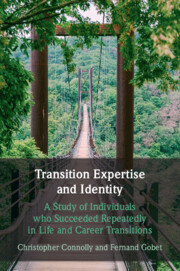 Transition Expertise and Identity
Transition Expertise and Identity Utilizing the Environment in Transitions
from Part II - Transition Expertise
Published online by Cambridge University Press: 30 May 2024
This chapter draws upon and integrates aspects of two well-researched hybrid models of intelligence: practical intelligence and social intelligence. Contextual intelligence addresses how individuals interact with their environment. Contextual intelligence in transitions operates in three main categories: (1) identifying environmental resources such as physical resources, enabling environments, education and training, or team resources; (2) identifying knowledge experts such as peers and mentors or external knowledge experts and stakeholders, who provide expert domain knowledge in diverse fields; and (3) understanding of the cultural and social milieu into which one is moving, whether this be understanding the cultural climate, accessing culturally embedded knowledge, using the right language, or ultimately navigating the politics of the new arena. Retrospective interviews with twenty-four elite performers in three domains (business, sports, and music) are used to investigate how contextual intelligence is used to successfully and repeatedly transition to higher positions within their field.
To save this book to your Kindle, first ensure [email protected] is added to your Approved Personal Document E-mail List under your Personal Document Settings on the Manage Your Content and Devices page of your Amazon account. Then enter the ‘name’ part of your Kindle email address below. Find out more about saving to your Kindle.
Note you can select to save to either the @free.kindle.com or @kindle.com variations. ‘@free.kindle.com’ emails are free but can only be saved to your device when it is connected to wi-fi. ‘@kindle.com’ emails can be delivered even when you are not connected to wi-fi, but note that service fees apply.
Find out more about the Kindle Personal Document Service.
To save content items to your account, please confirm that you agree to abide by our usage policies. If this is the first time you use this feature, you will be asked to authorise Cambridge Core to connect with your account. Find out more about saving content to Dropbox.
To save content items to your account, please confirm that you agree to abide by our usage policies. If this is the first time you use this feature, you will be asked to authorise Cambridge Core to connect with your account. Find out more about saving content to Google Drive.